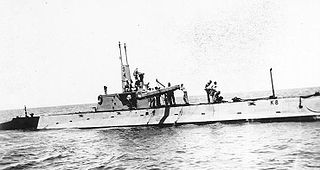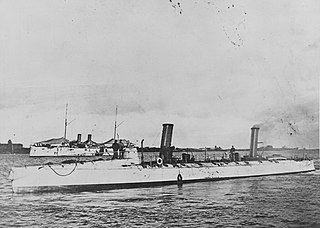
USS Adder, later renamed A-2, was one of seven Plunger-class submarines built for the United States Navy (USN) in the first decade of the 20th century.

USS K-8 (SS-39) was a K-class submarine of the United States Navy. Her keel was laid down by the Union Iron Works in San Francisco, California, under subcontract from Electric Boat Company of Groton, Connecticut. She was launched on 11 July 1914 sponsored by Mrs. John W. Lewis, wife of the first commanding officer, and commissioned on 1 December at Mare Island.

USS Cushing was a torpedo boat in the United States Navy during the Spanish–American War. She was named for William B. Cushing.

USS Stringham was a steel torpedo boat in the United States Navy. Stringham was named for Silas H. Stringham, who served in the United States Navy from the War of 1812 through the American Civil War.

The second USS Amphitrite—the lead ship in her class of iron-hulled, twin-screw monitors—was laid down, on June 23, 1874 by order of President Ulysses S. Grant's Secretary of Navy George M. Robeson at Wilmington, Delaware, by the Harlan and Hollingsworth yard; launched on 7 June 1883; sponsored by Miss Nellie Benson, the daughter of a Harlan and Hollingsworth official; and commissioned at the Norfolk Navy Yard, Portsmouth, Virginia, on 23 April 1895, Captain William C. Wise in command.

USS Winslow was a United States Navy torpedo boat noted for its involvement at the First and Second Battle of Cardenas during the Spanish–American War. She was named for Rear Admiral John Ancrum Winslow.

The first USS Ericsson was the second torpedo boat built for the United States Navy. The first,Cushing, had been built seven years earlier.

The first USS Du Pont was launched 30 March 1897 by Herreshoff Manufacturing Co., Bristol, R.I.; sponsored by Miss L. Converse; and commissioned 23 September 1897, Lieutenant Spencer S. Wood in command.

The first USS Gwin, was launched 15 November 1897 by the Herreshoff Manufacturing Co., Bristol, Rhode Island, and commissioned at Newport 4 April 1898, Lt, (j.g.) C. S. Williams in command.

The first USS MacKenzie, was laid down by Charles Hillman Ship & Engine Building Company, Philadelphia, 15 April 1897; launched 19 February 1898; sponsored by Master Charles Hillman; and commissioned 1 May 1899.
The first USS McKee was laid down on 11 September 1897 by Columbian Iron Works, Baltimore, Maryland, United States, launched 5 March 1898; sponsored by Mrs. William H. Humrichouse; and commissioned 16 May 1898.

The second USS Bailey was laid down on 30 April 1898 at Morris Heights, N.Y., by the Gas Engine & Power Co. & Charles L. Seabury Co.; launched on 5 December 1899; sponsored by Miss Florence Beekman Bailey; and commissioned at the New York Navy Yard on 10 June 1901, Lt. George W. Williams in command.

USS Manley more often spelled Manly, was built by Yarrow & Co., Ltd., Poplar, London, England; purchased from Charles R. Flint 13 April 1898 during the Spanish–American War; and delivered to the New York Navy Yard to be placed in service.

USS Bagley was a torpedo boat in service with the US Navy between 1898 and 1919, named after Ensign Worth Bagley.

The first USS Barney was laid down on 3 January 1900 at Bath, Maine, by the Bath Iron Works; launched on 28 July 1900 and sponsored by Miss Esther Nicholson Barney, great-granddaughter of Commodore Joshua Barney; and placed in commission at the Naval Torpedo Station, Newport, Rhode Island, on 21 October 1901.

USS Seneca (AT-91) was a Navajo-class fleet tug constructed for the United States Navy during World War II. Her purpose was to aid ships, usually by towing, on the high seas or in combat or post-combat areas, plus "other duties as assigned." She served in the Atlantic Ocean performing various tasks.

USS Sandoval (1895) was an Alvarado-class gunboat acquired by the United States Navy from the Spanish as a prize-of-war. Duties assigned her by the Navy included patrolling coastal and river waterways, and, later, acting as a "practice ship" for the United States Naval Academy at Annapolis, Maryland and for the New York Naval Militia as well.

The second USS Wando, later YT-17, later YT-123, later YTB-123, was a United States Navy tug in commission from 1917 to 1946.
USS Nina was a United States Navy steamer commissioned in 1866. She served in a variety of roles — as a tug, torpedo boat, torpedo boat tender, salvage ship, supply ship, and submarine tender — before she sank in a storm in 1910.

Acushnet – a steel-hulled revenue cutter – was launched on 16 May 1908 at Newport News, Virginia, by the Newport News Shipbuilding and Drydock Co.; sponsored by Miss Alayce Duff; and commissioned at Baltimore on 6 November 1908. She saw service as a United States Revenue Cutter Service cutter, a U.S. Navy fleet tug, and as a U.S. Coast Guard cutter. She was taken out of service 8 January 1946.



















